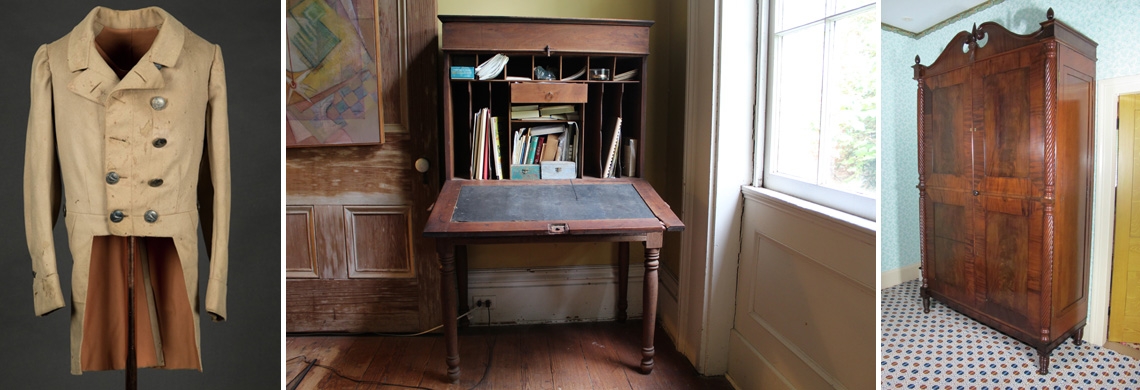In its work documenting pre-1865 artifacts across the region, the Decorative Arts of the Gulf South (DAGS) team is always on the lookout for objects related to Black American history. Black Americans, most of them enslaved, made up nearly half the combined populations of Louisiana, Mississippi, and Alabama in the mid-19th century. Unfortunately, their possessions can be hard to find today.
A byproduct of the brutal living and working conditions of enslaved people is that their garments and tools have not survived the test of time. They often had only one or two sets of basic clothing, and they did not earn income for decorative items or everyday comforts. After emancipation Black families did not have the generational wealth to maintain family collections like their former enslavers did. The Great Migration northward in the early 20th century further scattered what family artifacts did survive.
Considered in their historical context, the surviving possessions of wealthy white plantation owners can indirectly reveal information about the lives of the people they enslaved. These include artifacts found at DAGS fieldwork sites, where many of the white owners enslaved over 100 people, according to “Slave Schedule” records from the 1850 and 1860 Censuses.
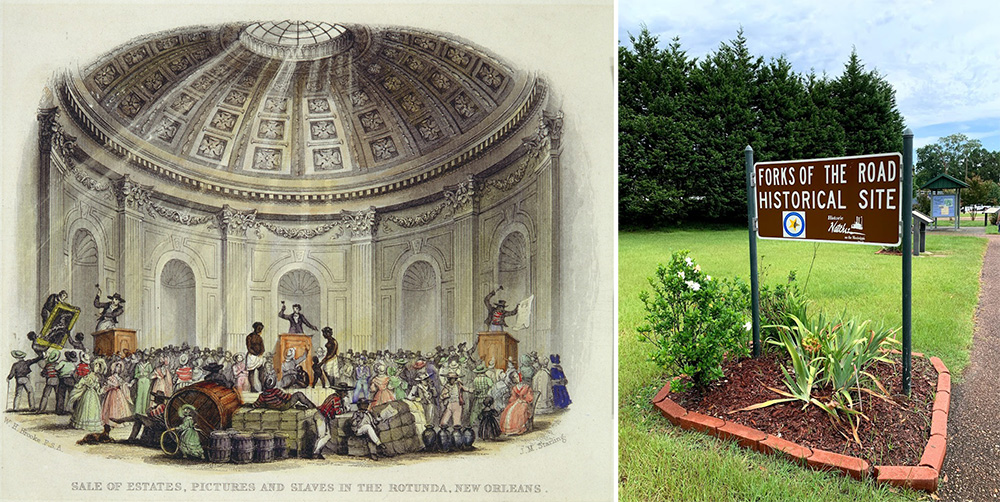
The fates of enslaved people were often decided at the chaotic auction blocks in New Orleans (left) or Natchez, Mississippi. At these locations, Black parents and children were often separated forever. (Left: THNOC, 1974.25.23.4. Right: Forks of the Road Historical Site, the former location of the slave market in Natchez.)
Every decorative object in a plantation mansion, from the Greek Revival porch columns to the French porcelain in the dining room, came from enslaved people’s stolen labor. Their toil in the fields funded their enslavers’ lifestyle, as did their work maintaining the elegant home and waiting on its residents. Throughout THNOC’s 2021 exhibition Pieces of History: Ten Years of Decorative Arts Fieldwork, interpretive text called attention to the ways enslaved people would have interacted with objects in every room of a plantation house.
There are many more physical clues about the lives of 19th-century Black Americans, though, if you know where to look. Read on to learn more about some of the DAGS team’s most interesting findings.
Two artifacts on view in Pieces of History specifically used by enslaved people are a basket from Wilkinson County, Mississippi, likely used to collect cotton, and a livery coat worn by a young man enslaved by Dr. William Newton Mercer of Natchez, Mississippi, and New Orleans. The basket came to a local museum from a neighboring cotton plantation, and its large size and simple construction indicate it served a practical rather than decorative purpose.
We do not know the name of the enslaved young man who wore the livery coat, but he likely lived at Mercer’s townhouse on Canal Street in New Orleans. Livery uniforms like these designated butlers and footmen who worked in entertaining spaces like parlors and dining rooms. Made by Brooks Brothers in New York and featuring silver buttons with Mercer’s falcon insignia, the coat signaled sophistication to Mercer’s guests—and hid the wearer behind his enslaver’s identity.
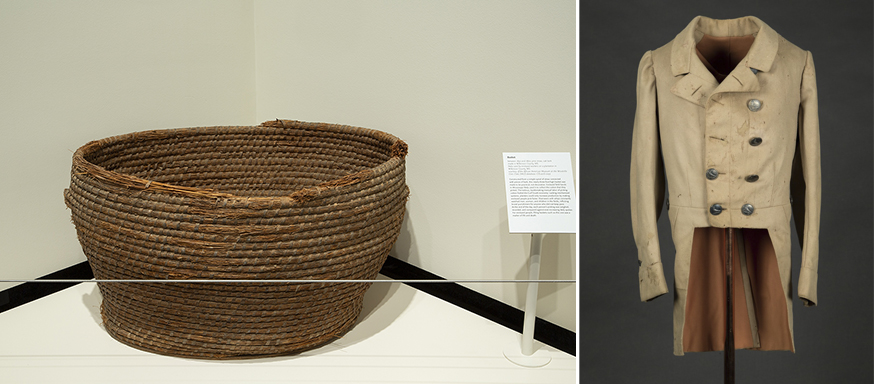
This basket, made between 1830 and 1860 of pine straw and oak bark was likely used by enslaved workers on a plantation in Wilkinson County, Mississippi. (courtesy of the African American Museum at the Woodville Civic Club; DAGS database: CIS-2016-0072). This Brooks Brothers livery coat, made of wool with silver buttons between 1857 and 1865, was worn by a young man enslaved by Dr. William Newton Mercer of Natchez and New Orleans. Despite their efforts, DAGS researchers were not able to identify the name of the individual(s) who may have worn the coat. (THNOC, 2013.0115.1; DAGS database: CIS-2011-0143)
DAGS has also documented several objects made by enslaved craftsmen whose skills have stood the test of time. One ladderback chair made of Mississippi ash wood still has its original rawhide leather seat tied and tacked in place. Its maker likely used a draw knife to shape the slats and stiles.
The 2019 DAGS team cataloged a collection of furniture with a clear chain of ownership and strong oral history connecting them to enslaved craftsmen at Peachland Plantation near Natchez. The group includes a variety of chairs and side tables made of cherrywood. The most complex item is a secretary desk with detailed turning and numerous storage compartments.
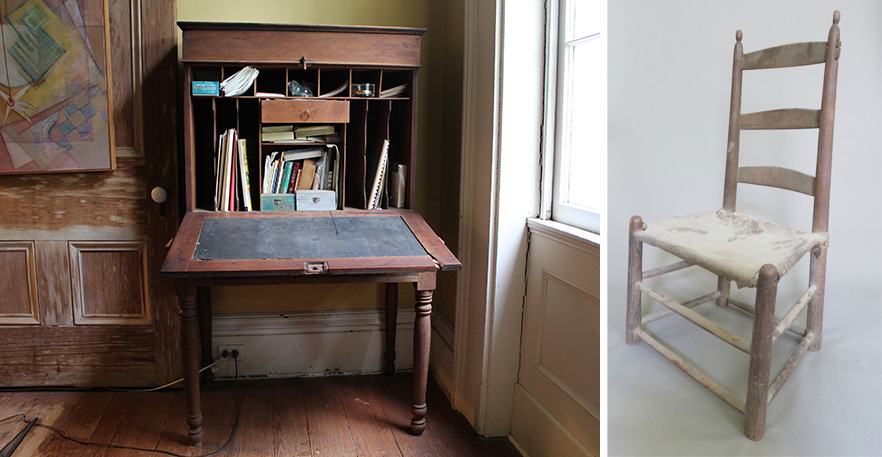
This secretary desk at Peachland Plantation, made of cherrywood, leather, and brass and dating to between 1830 and 1850, was made by an unknown enslaved craftsman in Adams County, Mississippi. (DAGS database: CIS-2019-0034); An enslaved craftsmen may have built this chair, which has a provenance in Adams County, Mississippi, and was made of ash wood and rawhide between 1800 and 1850. (DAGS database: CIS-2012-1118)
One of the most comprehensive examples of Black American material culture documented by the DAGS team came during fieldwork in 2013 at the William Johnson House in Natchez, Mississippi. William Johnson was born into slavery in Mississippi in 1809 but was emancipated at age 11. After an apprenticeship as a barber, he opened his own barbershop business with an initial investment of $300. By 1835 he was a successful and prominent businessman, with that investment multiplied to almost $3,000. Today, the townhouse where he and his wife Ann Battles had 11 children is a museum run by the National Park Service.
William Johnson kept a diary that reveals the complexities and contradictions of his life as a free man of color. Most free Black people in Mississippi before the Civil War lived in Natchez, largely due to restrictive laws limiting where they could operate businesses. Despite these and other legal limitations, Johnson and the rest of Natchez’s free Black community found close friendships and financial success.
Ironically, that prosperity sometimes involved enslaving other Black people. Johnson owned 16 people at the time of his death. His violent end was unfortunately another example of legal inequality. After a boundary dispute with neighbor Baylor Winn, Winn ambushed Johnson on the road and shot him. Due to some racial legal loopholes, the only witness was not allowed to testify, and so William Johnson’s murder went unpunished.
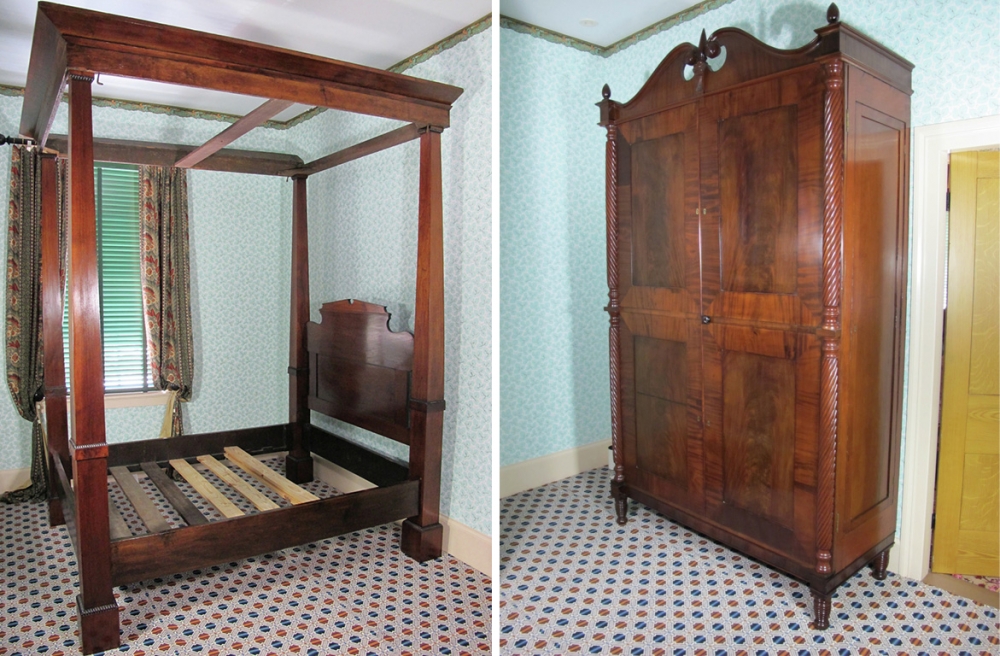
William Johnson’s bedstead, built between 1835 and 1850, was made of walnut, yellow pine, tulip poplar, iron, and steel. (Natchez National Historic Park, DAGS database: CIS-2013-1147) His armoire, dating to the same time period, was made of cherry, tulip poplar, cypress, iron, and brass. (Natchez National Historic Park, DAGS database: CIS-2013-1149.)
In coming years, the DAGS team will continue to seek out more evidence of the lives of Black Americans who shaped the Gulf South region. Research into inventories, census records, and city directories will continue to shed light on the people enslaved at plantations. Touring local historic landmarks and house museums often reveals stories of local free craftsmen who are unknown outside their hometowns.
There is much scholarly work to be done exploring and documenting African American history, and DAGS has the responsibility and privilege of contributing to that conversation.
In June 2021, as part of its exhibition Pieces of History, THNOC hosted a virtual discussion about the material culture of early Black Americans with scholars Tara Dudley, Joseph McGill, and Tiffany Momon; the full recording of that event is available on YouTube.

